ABP 036
Code: ABP 036
Country: Tibet (central)
Style:
Date: 1700 - 1800
Dimensions in cm WxHxD: 204 x 94
Materials: Glue distemper on cotton
(From Wikipedia, the free encyclopedia)
A Chakravartin (cakra-vartin, a Sanskrit bahuvrihi, literally "whose wheels are moving", in the sense of "whose chariot is rolling everywhere without obstruction"; Pali cakkavatti, also interpreted as "for whom the Wheel of Dharma is turning") is a term used in Indian religions for an ideal universal ruler, who rules ethically and benevolently over the entire world. Such a ruler's reign is called sarvabhauma.
In Buddhism and Jainism, three types of Chakravartins are distinguished:
* cakravala cakravartin, a ruler over all four continents postulated in ancient Indian cosmography
* dvipa cakravartin a ruler over only one of four continents
* pradesa cakravartin, a ruler over only part of a continent.
The first references to a cakravala cakravartin appear in monuments of the Maurya period, dedicated to Ashoka the Great. It has not been generally used for any other historic figure. The cakravartin in Buddhism came to be considered the secular counterpart of a Buddha. According to Buddha Shakyamuni a woman can never be(come) a chakravartin. "Women are said to have five obstacles, namely being incapable of becoming a Brahma King, “Sakra” , King “Mara”, Cakravartin or Buddha."
The Maitreyi Upanishad uses the term for kings who had renounced their royal prerogatives in favour of asceticism.
In general, the term applies to temporal as also to spiritual kingship and leadership, particularly in Buddhism and Jainism. In Hinduism, the term generally denotes a powerful ruler, whose dominion extended to the entire earth.
Mahabharata
In the Mahabharata, twelve princes beginning with Bharata are considered Chakravartins:
* Bharat was the son of the Puru Dynasty. India (Bharat) is named after him. He was able to conquer the whole subcontinent. There are some disputes over whether Bharat conquered India or certain parts of India. Some believe that he even conquered regions outside of the Subcontinent such as Afghanistan (then referred to as Gandhara) and Tibet (then referred to as Bhuta.)
* Ikshvaku, the son of Ila of the Suryavanshi lineage after whom India was named (Ilavarta and Eelam) in Hindu mythology he is said to have conquered the world. This might have just been referring India alone as the world's ancient peoples saw the region in which their peoples live as the world itself.
* Shibi, famous in Hindu and Buddhist mythology. He sacrificed his flesh. There have been several dynasties which have claimed heritage from Emperor Shibi's line. The Cholas were one of the dynasties and they referred to him as Sembiyan.
* Imayavaramban Neduncheralathan, a Sangam age king said in inscriptions to have conquered up to the Himalayas.
Jainism
* Adinath, the 1st Tirthankar and is said to be the father of King Bharat.
* Shantinath, the 16th Tirthankar thought to have ruled the whole of India.
In Jainism, a chakravartin was characterized by possession of saptaratna, that is, the seven jewels, consisting of, charka, queen, chariot, jewel, wealth, horse, and elephant. Additionally, the list also included a prime minister and a son (navaratna). A chakravartin is considered an ideal human being endowed with thirty-two major signs of excellence and many minor signs of excellence.
Important quote:
“ Buddhist and Jain literatures describe their enlightened founders (the Buddha or Buddhas and the tirthankaras, respectively) in similar terms, the notion being that religious truth transcends local or national limitations and applies to all people everywhere. This idea is particularly evident in Buddhist oral and scriptural traditions, which frequently refer to Gautama as a cakravala cakravartin, an illuminator of dharma (life in adherence to compassionate truth) in all regions of the world.”
Beer, Robert , 2003. Les symboles du bouddhisme Tibétain. Albin Michel. P. 70-88
Essen, Gerd-Wolfgang and Thingo, Tsering Tashi, 1990. Die Götter des Himalaya - Buddhistische Kunst Tibets. München: Prestel-Verlag. Band I, pp. 250–55, nos. I-154–158, Band II, pp. 223–26, nos. II-463–475
Hurman, Robert A.. and Weldon, David, 1999. Sacred Symbols – The Ritual Art of Tibet. Sotheby's and Rossi & Rossi. Pp. 152–53, no. 70
Martin du Gard, Irène , 1985. “Une peinture d’offrandes à dPal-ldan dmag-zor rgyal-ma”, Arts Asiatiques, Tome XL. EFEO, Musée Guimet. Arts Asiatiques, Tome XL, pp. 68–82, 18 illus
Pal, Pratapaditya, 1990. Art of Tibet: A Catalogue of the Los Angeles County Museum of Art Collection. Los Angeles: The Los Angeles County Museum of Art. 2nd revised edition - pp. 96, 166–68, nos. P30–P31




